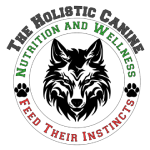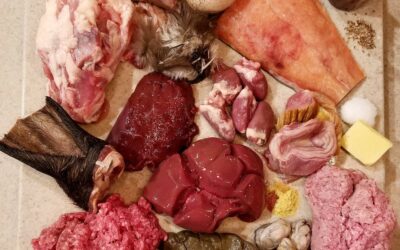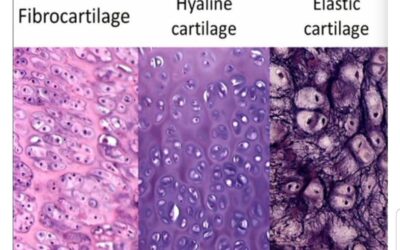In Parts I through III, I briefly discussed the anatomy and physiology of the canine to show what a dog is designed and meant to consume as well as the specific nutrients that dogs must receive from those foods in order to prevent nutrient-deficient pathologies and premature death. I also touched on the work of the NRC and AAFCO in determining nutrient minimums that have prevented nutrient-deficient pathologies in dogs consuming commercial foods. Thus we have a baseline, and in the instance of a few nutrients, we know the safe upper limits (SUL). And yet of all the information I have provided, what may possibly be the most important is the understanding that nutrients obtained from synthetic and inorganic laboratory produced isolates do not and cannot produce optimal health. I would like to briefly recap.
Nutrients perform synergistically. Some are antagonistic; others are dependent upon other nutrients, cofactors, and enzymes for absorption and/or function. Separating nutrients from their sources removes them from the web of interaction and cooperation. Man’s attempt at copying what nature has provided in her perfection via the creation of synthetic isolated pseudo-nutrients has created a host of difficulties. For one, synthetic nutrients are in no way similar to the biological process by which plants and animals manufacture, utilize, and/or store them. The nutrient structures that are reproduced in the laboratory, despite being similar, do not equate to a biological system recognizing, utilizing, processing, and storing them in the same manner as naturally occurring food nutrients. In fact, because of their isolated form, imbalances are far more probable creating the increased likelihood for deficiencies and toxicities. We know this to be true because studies on supplemental nutrients have been underway for decades. Sadly, of the thousands of studies performed most of the objectively unbiased studies are still concluding that synthetic nutrient supplements have no positive effect on the body. According to multiple articles found on The National Center for Biotechnology Information’s website, multivitamin supplementation use has led to an increased risk for cancer. It is unfortunate that there still exists no demonstrable evidence suggesting that synthetic nutrients are beneficial, especially in an already healthy body that does not require them.
The majority of commercially prepared processed dog foods are laden with synthetic and inorganic nutrient isolates. Not only are the adulterated and rendered ingredients (complete with copious amounts of carbohydrate and fiber fillers) biologically inappropriate for a dog, so too are the laboratory-produced nutrients added to make them comply with AAFCO’s “complete and balanced” nutrient standards. Dogs who are consuming these commercially processed foods are hit with this destructive double whammy. And yet, as mentioned in the previous parts of this blog series, dogs are extremely hardy, and as a result, many dogs ARE living long lives despite consuming these less-than-ideal foods. Nevertheless, the remaining higher percentage of pets are stricken with a life of suffering from minor to major health conditions and finally succumbing to chronic disease and cancer. Now imagine, if pets are able to survive while being nutritionally abused through the consumption of these processed and synthetic foods and nutrients, how much more will they thrive when switched to a biologically-appropriate fresh-foods diet teeming with naturally occurring food-sourced nutrients. And so, we have now come back to our focus: food-sourced, naturally occurring, organic nutrients. How can we be sure to provide our pets with a balanced diet that not only meets AAFCOs “complete and balanced” standards and the NRCs nutrient minimums, but exceeds them through nature’s biologically-appropriate nutrients? You will do this by following my HN/Br plan for creating nutrient-rich meals.
For the informed and educated pet parent motivated to provide their pet with the highest-quality biologically-appropriate nutrition plan, feeding my highest nutrient per bite ratio (HN/Br) is the easiest way to ensure your dog will meet their nutrient needs without having to rely heavily upon supplementation. Before embarking on a homemade raw-food journey, you will have homework to do. You must first determine your dog’s baseline nutrient requirements. You will find a complimentary nutrient calculator on my business website that will determine your dog’s NRC minimum nutrient requirements based on your dog’s weight. This will be your baseline (be sure to print or record them so you have these values handy.). Once you have received your nutrient minimums, it is highly recommended that you further research your dog’s breed to discover common health problems and conditions, common gene mutations, and breed disease-predispositions. Also look into his/her pedigree (or parents) for any conditions that may have been genetically passed on. If you have a dog with an unknown breeder and pedigree, you may want to consider using a DNA test to check for any possible conditions. Embark Dog DNA Test checks for 165 genetic conditions. This is highly advised if your dog’s ancestry is unknown and you desire to cultivate optimal health and longevity. The reason for checking into your dog’s background is for the purpose of raising specific nutrients that support the body and assist in the prevention of potential predisposed conditions. For all the information you will discover, follow that up by looking into preventative measures and what is advised and recommended by either The Holistic Canine, your holistic veterinarian, or another nutrition/naturopathic pet professional. Once you have your nutrient baseline and all necessary information for preventing possible conditions or disease in the future, you are ready to begin creating meals. This may all sound overwhelming, but really it is not. Start with your breeder or the internet and do as much research as you are able without assistance. If you require a nutritionist or holistic veterinarian, especially one who specializes in food therapy, you have one right here. The Holistic Canine can be contacted for further support. Simply use our contact page, visit our Facebook page, or email us at wellnessforlife18@yahoo.com.
The highest nutrient per bite ratio (HN/Br) is a simple way of choosing foods that are nutrient saturated. You will need to discover and then source the biologically-appropriate foods and meal ingredients that are most nutrient saturated in order to cover a large portion of your dog’s nutritional requirements with those foods. I call these broad spectrum foods. Ingredients you will be sourcing are muscle meats and fish, muscle organs, secreting organs, eggs, and bone. You may also wish to add vegetation, seeds, and a variety of other foods or ingredients that are nutrient-rich and specifically beneficial to your dog. You may find as you begin offering more and more foods that your dog may occasionally have loose stools or diarrhea (rare is constipation an issue unless you are feeding far too much bone). Pay close attention to your dog’s stools. Stools are a key to informing you which foods are beneficial, which foods may be causing issues, foods that are not being tolerated well, or that the meals you are providing may be unbalanced.
To learn what nutrients are in the foods and ingredients that you will be including in meals, you will need to refer to nutrition apps, nutrition websites, and/or meal designer programs that have databases of the hypothetical nutrient profiles of most foods. I prefer to use Cronometer. While the macronutrient food values are generally accurate (proteins, fat, and carbohydrates), please understand that the micronutrient (vitamins and minerals) nutritional profiles are averages and hypothetical values ONLY. What this means is that the ingredients you purchase may not actually contain the nutrients that are hypothetically in the average same-food. The databases are simply reference guides. To ensure that the foods you purchase and feed to your dog are actually nutrient-rich, you will need to purchase the highest quality possible. Choose quality ingredients that you are able to source and afford then look-up their nutritional profiles in the database(s). Compare these profiles to your dog’s nutrient needs. You will then need to discover which foods fall under the HN/Br and put those at the top of your list to be fed as priority foods (more on this coming up). Organ meats consistently fall under HN/Br. Organs are nature’s multi-vitamins and -minerals! To begin creating meals, refer to the following ratio guideline.
The following percentage ratio is a GUIDELINE to creating a meal:
80/10/10
80% = muscle meats. This category is further broken down to 65/15: 65% = superficial muscle, 15% = organ muscle.
10% = bone. This is an approximate. Prey, on the average, contains 12% bone. Puppies require 15% bone. Some dogs do better with 12% bone rather than 10%. You will need to discover what is best for YOUR dog.
10% = secreting organs. This category is further broken down to 5/5: 5% liver, 5% other secreting organ.
80/10/10 is the simplified version of this more accurate ratio 65/15/10/5/5.
I emphasize guideline because many pet parents mistakenly believe that this ratio means “nutrient balanced” and/or that it must be exactly followed; however, nothing could be further from the truth. A pet parent may follow the ratio perfectly and have provided meals that yield next to no micronutrients that their dog must have to be healthy and prevent disease, and/or may be supplying unbalanced macronutrients. The ingredients and foods you choose is first and foremost the most important factor in creating adequate nutrient-balanced meals. Once you have determined your HN/Br foods (those nutrient saturated foods that will more than cover your dog’s nutrient requirements), place those into the ratio guideline above to create the actual meals. To receive The Holistic Canine’s Raw Feeding Guide resource, please join our Facebook community or contact us to receive the pdf copy. The following is a list of ingredients from which you will find HN/Br foods and create meals. Note these are not exhaustive lists, merely easiest-to-source ingredients.
Muscle meats (superficial): 65% Muscle organs: 15%
- Beef (grass-fed is best) Heart
- Goat (pasture-raised is best) Gizzards
- Lamb (pasture-raised is best) Lung
- Rabbit Green tripe
- Pork (pasture-raised is best) Tongue
- Chicken (free-range is best) Trachea*
- Turkey (free-range is best) Cheek (not technically an organ)
- Quail
- Duck
- Sardines
- Salmon (wild-caught only)
- Whiting (wild-caught)
- Herring, mackerel (wild-caught)
- Smelts
- Trout
- Oysters
- Off-cuts, briskets, and fillets Eggs (chicken, duck, quail, etc. from pasture-raised birds)
Bone: 10%
- Chicken quarters (thighs, drumsticks)
- Chicken feet
- Chicken necks
- Chicken wings
- Chicken backs
- Poultry carcass
- Turkey necks
- Turkey wings
- Turkey backs
- Duck wings
- Duck head
- Quail, whole
- Cornish hen, whole
- Rabbit thigh, ribs, feet
- Goat/lamb neck
- Goat/lamb rib
- Pork rib
- Pig feet
- Ox tail
- Eggshell**
Organs, secreting: 10%
- Liver 5%: beef, calf, chicken, pork, duck, rabbit, goat, lamb, venison
- Kidney: beef, pork, rabbit, goat, lamb, venison, poultry/fowl
- Spleen
- Pancreas
- Brain
- Testicles* (not recommended for an intact male, but excellent if neutered!)
- Ovaries* (not recommended for an intact female, but excellent if spayed!)
- Thymus (sweetbreads)
Look specifically for foods that will also cover the more difficult to meet nutrients. These include manganese, zinc, copper, iron, magnesium, iodine, Vitamin D, and Vitamin E. Unfortunately, when we are relying on nutritional information for human foods we are not always able to find nutrient information on foods that people would not commonly eat, yet foods that we do feed to our dogs. For example, magnesium, manganese, zinc, and iron commonly come up low when we are trying to source for these nutrients. One of the reasons this happens is because human nutritional data does not provide information on bones. Wild dogs do not seem to have a problem sourcing all of their nutrients. One of the reasons is likely because bone and marrow contains those hard-to-source nutrients. Bone contains calcium, phosphorus, magnesium, sodium, chloride, sulfur, potassium, and silica, while marrow contains iron, zinc, selenium, manganese, boron, Vitamins A & K, and fatty acids. Another major source of manganese is fur and feathers, specifically the reds. Humans certainly do not consume bones, fur and feathers or many of the organs that we can feed to our dogs, thus nutritional information is not provided for these important foods. This is a major problem with relying on human nutritional information. Note that even the pet diet designer programs are limited to the same human nutrition information. If you are feeding bones, none of your meal recipes will come up accurate in these programs. Dogs Naturally Magazine has developed a calculator that accounts for bone. Please join our Facebook community to have access to this free resource.
One of the most important tips that I give to my clients is also one that will help keep you out of the dark when it comes to unknown nutritional information. If you want your dog’s organs, muscles, eyes, vessels, bones, etc. to be healthy, FEED THOSE PARTS. Those same nutrients that each part of your dog’s body requires for health are found in the food parts. This is one way to know what is in some of the foods we offer to our dogs. Again, if we are aware of which nutrients are needed for the health of each organ, bones, eyes, blood, muscles, joints, and ligaments, for example, we can conclude that many of those nutrients are found in those parts that we can offer as food to our dogs. Organs store a wealth of nutrients. Because organs are so rich in nutrients, we can only feed so much without the possibility of hypervitaminosis, a toxicity condition from too much Vitamins A, D, and B (especially B12).
When sourcing for particular nutrients, for the same reason I mentioned above, many foods which we are feeding to our dogs are not listed in human nutrition databases. As a result, it appears that some of those audited meals are coming up short in several nutrients. As a warning, please do not fall for the same mistakes many raw feeders are making under the guise of “science-based” meal planning. Many of these pet parents who are relying solely on human nutrition databases and programs will then turn to inappropriate food sources to meet a nutrient need. Inappropriate food sources commonly used by so-called “science-based” food database groupies are oatmeal, quinoa, brown rice, potatoes, legumes, beans, peas, and others. These foods are in direct opposition to my HN/Br. Not only do they not have a broad spectrum nutrient profile, but they are only hypothetically filling a mere one, maybe two, nutrient gap(s) while also creating an issue with empty calorie space. I emphasize hypothetically because firstly, these foods are biologically-inappropriate to a canine; secondly, every one of those species-inappropriate foods contains health-destroying anti-nutrients which bind other minerals from being absorbed, and thirdly, they all require the necessity of first soaking, then sprouting, then cooking, and then cooking some more as well as the addition of the enzyme phytase which is destroyed by cooking. This is also in direct opposition to raw feeding. (More on grains in Part V.) These foods should not a have place in your dog’s diet.
How you will choose HN/Br foods to be added to meals is through nutritional comparison. Use cronometer to find nutrient values for the foods you will offer your dog. As an example, grass-fed ground beef contains far more iron than chicken, while the beef heart contains more than double the iron than the ground beef, yet chicken hearts have more than double the iron found in beef heart. So for iron we can look to chicken hearts. But what else do chicken hearts contain to make it worth feeding? Remember, we want broad spectrum foods, not foods that cover a mere one or two nutrient(s). Chicken hearts are rich in taurine, an amino acid that helps prevent taurine-deficient dilated cardiomyopathy (DCM), they are one of the richest animal sources of folate (needed for DNA methylation1), they contain more zinc than ground beef and beef heart, they are an excellent source of B vitamins, and coenzyme Q10. We can conclude that chicken hearts would classify as a HN/Br food. However, that does not mean that you don’t also feed the comparison foods. We will simply rely on the HN/Br foods to cover a broad spectrum of nutrients while also feeding the other ingredients to further meet nutrient requirements. It all adds up, but when you feed HN/Br foods in every meal, you can more than meet nutrient minimums. Let me give another example, beef liver is a rich source of copper, chicken liver contains only trace amounts. Chicken liver is slightly higher in iron; however, beef liver also wins for Vitamin A and all of the B vitamins. So beef liver comes under the HN/Br foods. You can rotate beef liver with pork liver which contains huge amounts of iron, equally high B vitamins, but next to no copper, and chicken liver which is higher in iron than beef liver but also contains huge amounts of folate. What I do is I rely on beef liver but also occasionally feed other liver or feed two different types of liver in one meal. Do the same for nutrient saturated vegetables and seeds.
Look up each of the more difficult to source nutrients by doing a web search for “richest food sources of [nutrient name].” Keep in mind that you will only pay attention to those foods that are biologically-appropriate and safe for a dog to consume. Discovering and adding these foods makes it even easier to fill all nutrient requirements. Once you have your list of HN/Br foods, you can begin to create meals with your meat and organ sources, vegetables, and other foods. You want to rely heavily of naturally occurring food nutrients and not on bottled supplements (and never ever on laboratory produced synthetic pseudo-nutrients).
It is also necessary to remember that you will need to balance fats. Feeding too much of the omega-6 fatty acids, such as from relying too heavily on chicken, can create an inflammatory environment in your dog’s body. Be sure to balance omega-6 foods with omega-3 containing foods. I find that offering chicken along with grass-fed beef and fatty fish, two sources of omega-3 fatty acids, balances the fat in the meal beautifully. If you are feeding oils, only offer those oils that will balance out the fats in your meats.
Another key to covering nutrient requirements is to use a vast variety of foods. And, do not remain stagnant with one or two recipes. Would this be beneficial for you to eat the same meal over and over? No. Neither would it be for your dog. Rotate where you source for foods as well. Every farm and every area of the world has different soils and weather patterns. You want to source locally as much as possible while also sourcing out. Feeding four or more protein sources in a meal is adequate and provides a broad spectrum of nutrient profiles.
Having learned how to create nutrient-rich meals, now is the time to determine where you need to supplement. I do use many supplements, most of which are whole-food sources of nutrients. I do not want to simply meet minimums, I want to provide the best possible nutrition plan that I am able. This most often requires adding “extras” to meals. Extras include vegetables, fruits, seeds, algae and phytoplanktons, medicinal mushrooms, oils, fermented foods, herbs, spices, and natural nutrients that are not synthetically manufactured. Always purchase natural or food sources of vitamins and minerals. If you need to boost minerals, food-source minerals are best followed by organic mineral chelates. Do not purchase inorganic minerals! Supplements can be very expensive, especially since you will want to purchase supplements for people unless you have found an excellent natural source of supplements for dogs (these are often more costly than human-grade). To keep cost at a minimum, be sure to meet nutrient needs through food ingredients first and foremost and add supplements where you absolutely must. Adding additional “superfood” supplements for disease prevention is a necessary secondary must if you are being proactive in preventing future disease in your dog. As a precaution, if you are purchasing individual vitamin and mineral isolates, purchase LOW doses. You do not want to mega-dose your dog. More is not better. Mega-doses are used for therapeutic purposes only.
Do your research and be sure that you are prepared and confident to begin a raw food nutrition program. You have valuable resources available through The Holistic Canine!
©2019 The Holistic Canine Written by Kimberly Lloyd, PhD, BCHHP, Cert Raw Dog Food Nutritionist
*hormone exposure is likely! This is NOT necessarily advantageous and may actually lead to hormone imbalance in intact dogs or dogs prone to thyroid disorder.
**eggshell is not a substitute for bones when feeding puppies. Puppies must have bone for proper calcium to phosphorous balance.
1 DNA methylation is an epigenetic mechanism used by cells that controls gene expression. DNA methylation is a commonly used epigenetic signaling tool that can fix genes in the “off” position.



